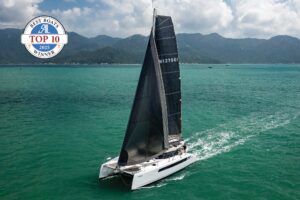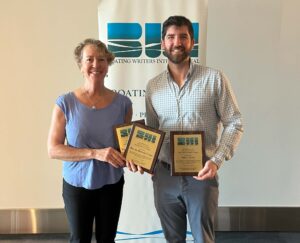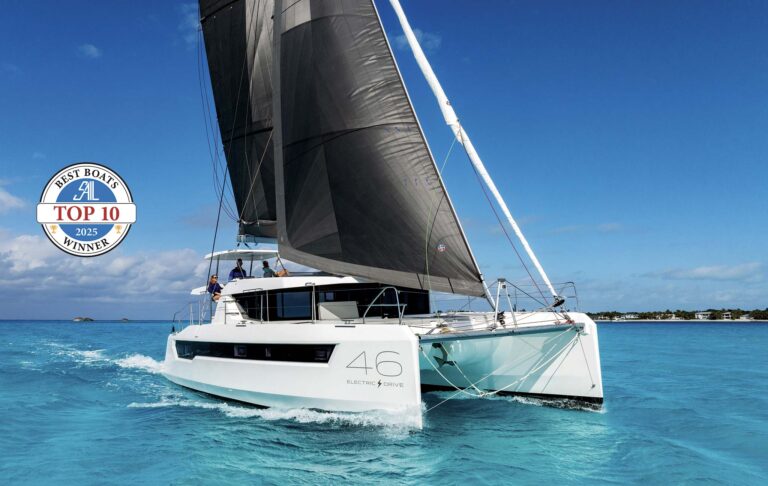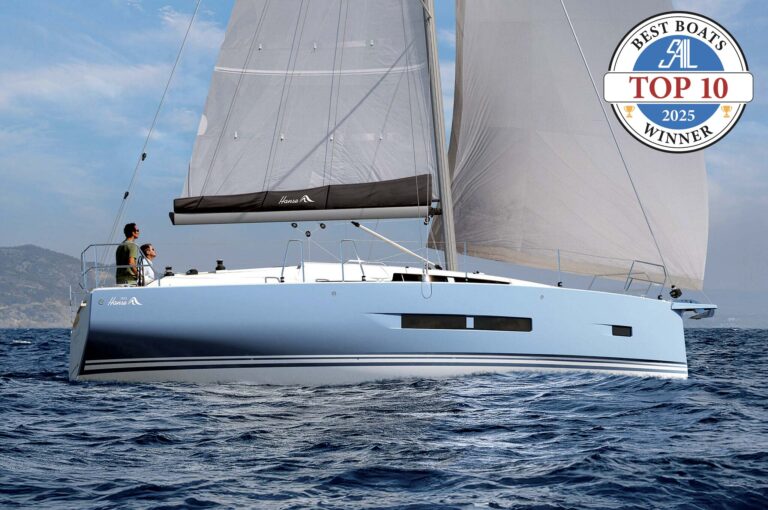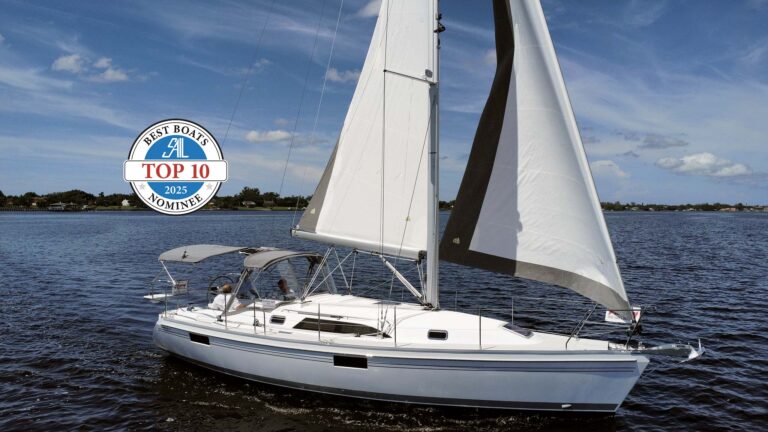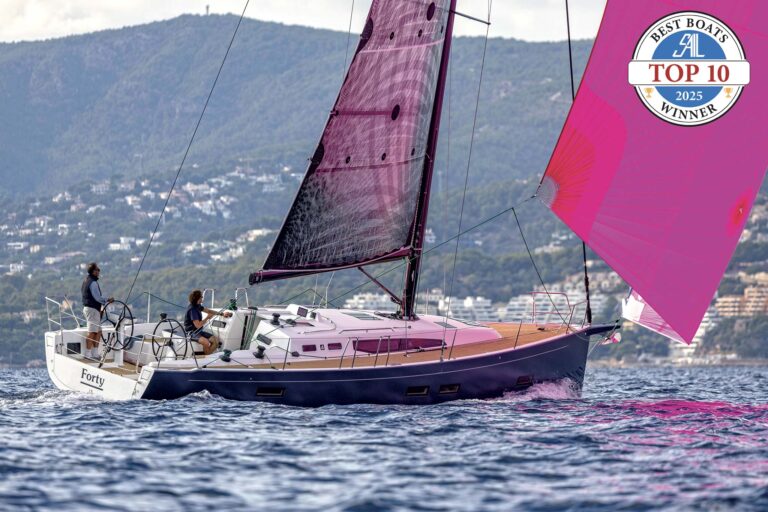
On the West Coast the heyday of the 70-foot sleds is remembered fondly, with good reason. Thanks to their light weight, those old sleds were not hard to manage, they were medium-tech so cost per foot wasn’t sky high, and you could race one with nothing more than a bunch of good sailors; forget the posse of full-time gunslingers. But the sled craze peaked in the early 1990s and later the West Coast fleet scattered. So that’s that, right?
Maybe not. One of the most successful boats in Southern California this past year was Peligroso, a Tim Kernan design aimed at reviving the good old days. As Kernan tells it, “The two owners had sailed almost everything—the 70s, the Beneteaus, the Transpac 52s, and the yachts with canting keels. But the question they kept asking each other was, ‘When was the last time we really had fun?’ The answer took them back to the sleds, and they decided to build a raceboat.” But it wouldn’t be an all-out raceboat; it would have some comforts.
Dale Williams, the Northern half of the Northern/Southern California partnership that campaigns Peligroso, spent a lot of time racing his previous boats in Southern California with his partner, who has asked that he not be named. Williams recalls, “One day we were sailing back from Catalina talking about the hard realities of racing Transpac 52s. The upshot was that we decided to buy an old 70-foot sled, fix it up, and get back to sailing with our friends.
“A phone call to Bill Lee netted the information that there weren’t any 70s for sale,” Williams says, “but then we began to think we could build a new yacht for what it would cost to bring back an old one. Dennis Choate gave us some preliminary numbers for building costs, but it wasn’t long before we switched from an entry-level sled to carbon fiber.”
Choate also introduced the two to Kernan, who went to work on a concept design that combined comfort and simplicity. Comfort in this case means eating well at sea—prepackaged meals are not allowed—and sleeping well, with hot showers on demand. Comfort means carrying a generator and not worrying about what it weighs. “I’ve always been funny about sacrificing comfort to save weight,” says Williams. “It seems to me that if you’re not comfortable, you’re not performing well, and you’re certainly not having fun. If we have to save weight, does that mean we take only skinny people for crew?” The answer was no, which is why these owners like to boast about having the only boat on the racecourse with a bagel toaster.
Simplicity was their second objective; on this yacht that means no overlapping jibs and no running backstays. “One of our goals,” says Williams, “is to still be enjoying this boat when she’s five years old. The surprise has been finding out how fast she is. When we came up winners in last year’s Yachting Cup in San Diego and then corrected out to first overall in the Ensenada Race—against 466 boats, and we beat Genuine Risk over the line. That got the handicappers’ attention. They held an emergency conference by phone and decided to hit us with another 12 seconds per mile. Then we went to Marina del Rey and won the Cal Cup.”
The yacht had other successes last year in the mild conditions of Southern California before earning a so-so record at the Big Boat Series last fall when high winds put Peligroso outside her optimal wind range. The next contest will be the 1,000-mile San Diego–
Puerto Vallarta Race, which starts February 21.
The inspiration for Peligroso also came in part from a day in which the two partners spent some time between races struggling to eat sandwiches in flying spray on the deck of a Transpac 52 while watching the crew of the 70-foot Taxi Dancer reach past them in comfort. To update the sled experience, Kernan looked at the Performance Handicap (PHRF) ratings of the entire fleet and made a conscious decision to design a boat that would fit within that ballpark. His starting point, however, was making sure there was a nice galley and comfy berths for the owners. That’s not where one usually starts with a raceboat design, but Kernan also worked up 6-foot, 9-inch headroom in the main saloon and used the curvature of the deckhouse to improve the yacht’s longitudinal stiffness.
Kernan insists on having his boats longitudinally stiff because a stiff hull doesn’t flex and dissipate energy driving through waves. A stiff hull also maintains tension on the headstay, which, in this case, is a hydraulic ram with a 14-inch throw. Ample framing in the yacht’s midsections further increases the longitudinal stiffness of the structure. And, says Kernan, “Dennis Choate has a track record of building light, stiff boats at a price point. In Peligroso he has achieved a high stiffness-to-price ratio.”
Choate built the hull upside down and built the deck at the same time. Multiple plies of lightweight carbon cloth were layered in a specially formulated WEST System epoxy that kept the components pliant and sandable at ambient temperatures. The complete structure, with all bulkheads and frames tabbed and bonded, was then baked as a single unit.
Kernan knows the hull doesn’t look like Pyewacket or a TP52. He recalls that while the hull was upside down, the peanut gallery would come by, scratch their heads knowingly, and pronounce that this one just wasn’t going to work.
Peligroso is a VMG yacht, designed for asymmetrical spinnakers. To succeed in Southern California buoy racing, a yacht has to be first to the mark in light to moderate winds. To succeed in the big coastal races it must step up and step out in moderate to heavy reaching conditions. Kernan started with low wetted surface for light-air performance and then created a hull shape that could deliver that optimal VMG at varying angles of heel. Forward sections are deep and veed to deliver a smooth ride and power through waves. The V shape turns to form a hard knuckle above the static waterline and carries into the mid-body, where the sections flare and fair into the body to contribute to what Kernan calls “an ideal planing surface” when the boat is running at heel angles of 10 to 15 degrees.
Four swept-back spreaders support the rig without running backstays, and nonoverlapping headsails allow the shrouds to connect to chainplates on the sheer. The wide base keeps the decks clear even as it decreases the compression on the rig and the stresses returned to the hull.
Peligroso’s project manager and professional captain, Mark Callahan, and the yacht’s regular crew provided key input on the deck layout. This was important because the long deckhouse needed for the accommodations below takes up 4 linear feet of what would, on a pure raceboat, be cockpit space. “Winch placement was refined down to the centimeter,” Kernan says. The cockpit winches are linked so that any winch can be cross-led to another. That means the spinnaker trimmer can work from any point on the deck.
The double-sided mainsheet leads under the side decks to two winches on opposite sides of the cockpit, which in turn are linked to a pedestal grinder. This arrangement not only doubles the gear options, it allows both ends of the sheet to be sucked in rapidly for safe gybing. On a similar note, a Harken step-up box for the primary pedestal winch lets the crew crank at what they call “ludicrous speed.”
All the navigation instruments are Bluetooth-linked and can feed data to a flat-screen TV belowdecks, where the off watch can keep an eye on how the on-watch is doing.
Belowdecks appointments are not exactly posh, but are well above today’s racing standard. Certainly they are nice enough to lure family and friends aboard for those important weekends at Catalina or for an occasional cruise in Mexico.
Specifications
Designer: Kernan Yacht Design
5820 E. Naples Plaza
Long Beach, CA 90803
tel. 562-987-5585;
www.kernandesign.com
Builder: Dencho Marine, Inc.
1417 W. 15th Street, Long Beach, CA 90813 tel. 888-460-7395;
www.denchomarine.com
LOA – 68’7”
LWL -61’7”
Beam- 14’4”
Draft – 10’11”
Displacement – 27,400 pounds
Ballast – 11,000 pounds
Sail area -1,969 sq ft
(100 percent foretriangle)
Auxiliary- 75-horsepower
Yanmar diesel with saildrive
Fuel- 50 gal
Water – 150 gal
Waste -35 gal
Sail area-displ. Ratio -34.66
Displ.-length ratio -52.27


